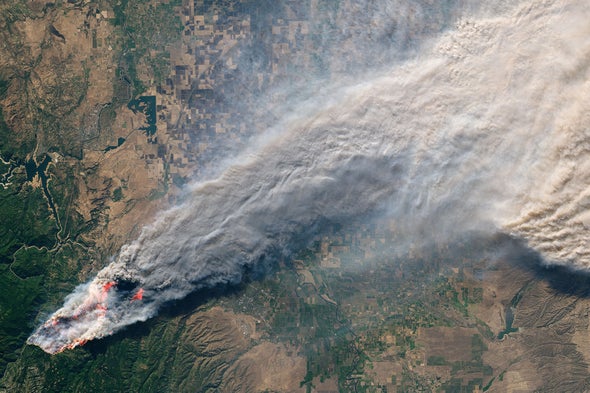Republican Presidential Candidates Vow to Fiddle as Earth Burns
Republican Presidential Candidates Vow to Fiddle as Earth Burns Scientific American


Republican Presidential Candidates Vow to Fiddle as Earth Burns

Introduction
Debates inescapably animate the American election circus, watched more for gaffes and missteps than genuine insight into presidential aspirants.
The Reality of Human-Mediated Global Warming
In August, however, the Republican presidential candidates’ debate detoured from the usual litany of empty soundbites into something darker: a collective dismissal of reality. When the eight hopefuls for the presidential nomination were asked to raise their hands if they believed in the reality of human-mediated global warming, every one declined to do so. One candidate, biotech entrepreneur and fossil-fuel stock peddler Vivek Ramaswamy, went even further, slamming the “climate change agenda” as a hoax.
The Incontrovertible Fact of Anthropogenic Climate Change
Despite the bluster of the Republican candidates, the incontrovertible fact remains that anthropogenic climate change is real. As swathes of the world swelter and burn and flood, the folly displayed at the debate makes it critical we understand why so many persist in denying reality.
The Overwhelming Scientific Consensus
For decades now, the overwhelming scientific consensus has been that we are rapidly altering Earth’s climate, with dangerous consequences. Worldwide, record highs of land and sea temperatures have fueled wildfires from North Europe to South America. Extreme temperatures are no longer an outlier on a planet warmed by 1.2 degrees Celsius since the preindustrial age. In Europe, last years’ record heat wave killed over 61,000 people, setting a temperature record that 2023 has already broken. Entire regions of the world teeter now at the brink of uninhabitability.
The Role of Ideology in Climate Change Denial
Even before the current crisis, this was a catastrophe predicted by basic physics; French polymath Joseph Fourier hypothesized human effects on climate as early as 1824, while the effects of greenhouse gases were demonstrated experimentally by Irish physicist John Tyndall in 1862.
Some argue that climate has always changed throughout Earth’s history. And while that is true, climate has never changed at such an alarming rate. Just as there’s a difference between bringing your car to a halt by gentle application of the brake versus ramming it full tilt into a brick wall, so too should a rapid rate of climate change concern us. Nor can we disavow responsibility by positing that climate change might be a natural phenomenon. The abundance of carbon dioxide in our atmosphere from fossil fuels point to our involvement as surely as the fingerprints on a smoking gun.
And yet, despite all this,
SDGs, Targets, and Indicators
1. Which SDGs are addressed or connected to the issues highlighted in the article?
- SDG 13: Climate Action
- SDG 1: No Poverty
- SDG 10: Reduced Inequalities
- SDG 16: Peace, Justice, and Strong Institutions
The article discusses the issue of climate change denial and its impact on addressing climate action (SDG 13). It also highlights how climate change disproportionately affects the world’s poorest, linking to the goal of no poverty (SDG 1) and reduced inequalities (SDG 10). Additionally, it touches on the role of ideology and political polarization in denying climate change, which relates to the need for strong institutions and peace and justice (SDG 16).
2. What specific targets under those SDGs can be identified based on the article’s content?
- Target 13.1: Strengthen resilience and adaptive capacity to climate-related hazards and natural disasters
- Target 1.1: By 2030, eradicate extreme poverty for all people everywhere
- Target 10.2: By 2030, empower and promote the social, economic, and political inclusion of all, irrespective of age, sex, disability, race, ethnicity, origin, religion or economic or other status
- Target 16.6: Develop effective, accountable and transparent institutions at all levels
The article emphasizes the need to strengthen resilience and adaptive capacity to climate-related hazards and natural disasters (Target 13.1). It also highlights the impact of climate change on the world’s poorest, emphasizing the need to eradicate extreme poverty (Target 1.1) and promote social, economic, and political inclusion (Target 10.2). Additionally, it discusses the role of ideology and its influence on denying climate change, emphasizing the need for effective, accountable, and transparent institutions (Target 16.6).
3. Are there any indicators mentioned or implied in the article that can be used to measure progress towards the identified targets?
- Indicator 13.1.1: Number of deaths, missing persons, and directly affected persons attributed to disasters per 100,000 population
- Indicator 1.1.1: Proportion of population below the international poverty line, by sex, age, employment status and geographical location
- Indicator 10.2.1: Proportion of people living below 50 percent of median income, by age, sex, and persons with disabilities
- Indicator 16.6.1: Primary government expenditures as a proportion of original approved budget, by sector (or by budget codes or similar)
The article does not explicitly mention indicators. However, based on the identified targets, the following indicators can be used to measure progress:
– Indicator 13.1.1 can measure the number of deaths, missing persons, and directly affected persons attributed to climate-related hazards and natural disasters.
– Indicator 1.1.1 can measure the proportion of the population below the international poverty line, considering various factors such as sex, age, employment status, and geographical location.
– Indicator 10.2.1 can measure the proportion of people living below 50 percent of the median income, taking into account age, sex, and persons with disabilities.
– Indicator 16.6.1 can measure the primary government expenditures as a proportion of the original approved budget, providing insights into the transparency and accountability of institutions.
Table: SDGs, Targets, and Indicators
| SDGs | Targets | Indicators |
|---|---|---|
| SDG 13: Climate Action | Target 13.1: Strengthen resilience and adaptive capacity to climate-related hazards and natural disasters | Indicator 13.1.1: Number of deaths, missing persons, and directly affected persons attributed to disasters per 100,000 population |
| SDG 1: No Poverty | Target 1.1: By 2030, eradicate extreme poverty for all people everywhere | Indicator 1.1.1: Proportion of population below the international poverty line, by sex, age, employment status and geographical location |
| Target 10.2: By 2030, empower and promote the social, economic, and political inclusion of all, irrespective of age, sex, disability, race, ethnicity, origin, religion or economic or other status | Indicator 10.2.1: Proportion of people living below 50 percent of median income, by age, sex, and persons with disabilities | |
| SDG 16: Peace, Justice, and Strong Institutions | Target 16.6: Develop effective, accountable and transparent institutions at all levels | Indicator 16.6.1: Primary government expenditures as a proportion of original approved budget, by sector (or by budget codes or similar) |
Behold! This splendid article springs forth from the wellspring of knowledge, shaped by a wondrous proprietary AI technology that delved into a vast ocean of data, illuminating the path towards the Sustainable Development Goals. Remember that all rights are reserved by SDG Investors LLC, empowering us to champion progress together.
Source: scientificamerican.com

Join us, as fellow seekers of change, on a transformative journey at https://sdgtalks.ai/welcome, where you can become a member and actively contribute to shaping a brighter future.







